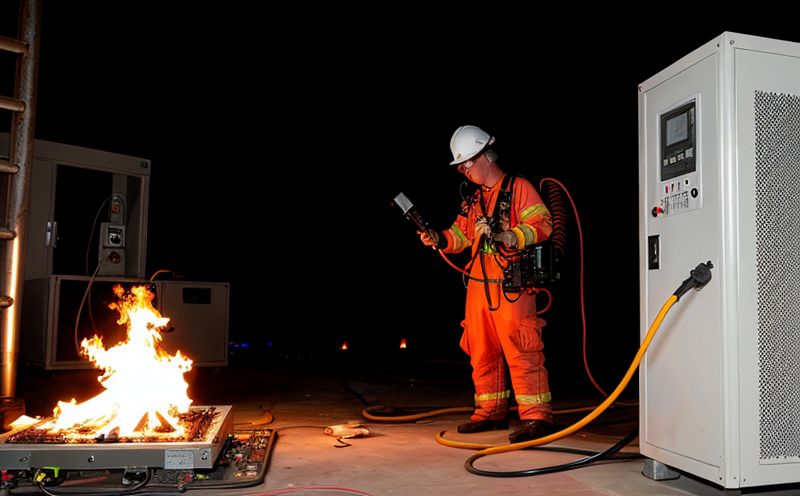Flammability Testing of Plastic Housings in Electronics
The flammability testing of plastic housings used in electronic devices is a critical aspect of ensuring product safety and compliance with international standards. This service ensures that the materials used in the manufacture of such products meet stringent fire safety requirements, thereby protecting consumers from potential hazards associated with electrical fires.
Flammability testing evaluates how easily a material ignites and burns under specified conditions. For plastic housings in electronics, this involves understanding not only the intrinsic properties of the plastic but also its behavior when exposed to heat sources such as those encountered during normal use or accidental situations like overcharging or overheating.
The standard test method typically employed for this purpose is ISO 17492-1:2018, which specifies the procedure for determining the burning rate of thermoplastics. This international standard ensures consistency across laboratories and provides a reliable measure of how quickly a sample will burn when exposed to an open flame.
During testing, samples are cut from actual products or fabricated according to specific dimensions outlined in the standard. Specimens undergo rigorous examination both before and after being subjected to thermal exposure. Post-test analysis focuses on measuring char depth, melt length, flaming duration, and non-flaming combustion time, among other parameters.
The outcome of this testing process plays a vital role in determining whether a product can pass muster with regulatory bodies like Underwriters Laboratories (UL) or the International Electrotechnical Commission (IEC). Compliance with these standards is essential for manufacturers aiming to penetrate global markets where stringent safety regulations apply.
Understanding the nuances involved in conducting flammability tests helps stakeholders appreciate why this service matters. By addressing potential risks early on, companies not only enhance their reputation but also contribute positively towards public health and safety efforts worldwide.
Benefits
The benefits of undergoing flammability testing extend beyond mere compliance; they encompass enhanced product reliability, improved consumer confidence, and increased market competitiveness. Here’s a closer look at these advantages:
- Enhanced Product Reliability: Reliable products built from well-tested materials are less likely to fail unexpectedly, especially under extreme conditions like overheating or short circuiting.
- Improved Consumer Confidence: When consumers know that the items they purchase meet high safety standards, trust increases, fostering loyalty and repeat business opportunities for manufacturers.
- Increased Market Competitiveness: Companies demonstrating proactive adherence to stringent testing protocols may gain an edge over competitors who do not prioritize similar precautions.
Besides these tangible gains, there are intangible benefits too. For instance, successful outcomes from rigorous quality assurance processes can lead to positive media coverage and enhanced brand reputation.
Competitive Advantage and Market Impact
In today’s competitive marketplace, achieving certification through thorough testing increases a company's market share by demonstrating commitment to excellence. Customers increasingly seek out brands that prioritize safety and quality above all else. Therefore, investing in robust testing services like flammability assessment can significantly enhance a brand's standing among consumers.
Moreover, compliance with international standards not only opens doors to larger markets but also ensures compatibility across different jurisdictions. This global acceptance is particularly important given the interconnected nature of modern supply chains and consumer preferences.
The importance of safety cannot be overstated. Accidents caused by defective electronic devices can have severe consequences ranging from minor inconveniences to life-threatening emergencies. By investing in comprehensive testing, manufacturers ensure that their products are safe for end-users while mitigating risks associated with non-compliance penalties.
Ultimately, the benefits extend beyond just preventing accidents; they contribute towards building a safer world where technology serves humanity without causing harm.
Use Cases and Application Examples
The application of flammability testing in electronic devices is widespread across various sectors. Some prominent examples include:
- Consumer Electronics: Smartphones, tablets, gaming consoles, and other portable gadgets are frequently exposed to heat sources during normal operation.
- Medical Devices: Portable diagnostic tools and monitoring equipment need to withstand environmental stresses without compromising patient safety.
- Automotive Systems: Advanced driver assistance systems (ADAS) rely on robust housing materials capable of withstanding high temperatures generated by engine components.
In each case, ensuring proper flammability testing helps prevent catastrophic failures that could endanger users. The data gathered during these tests informs design decisions aimed at improving product durability and reducing risks associated with unexpected fire incidents.
Understanding the specific requirements of different industries allows us to tailor our approach accordingly, providing accurate results that meet industry expectations.





